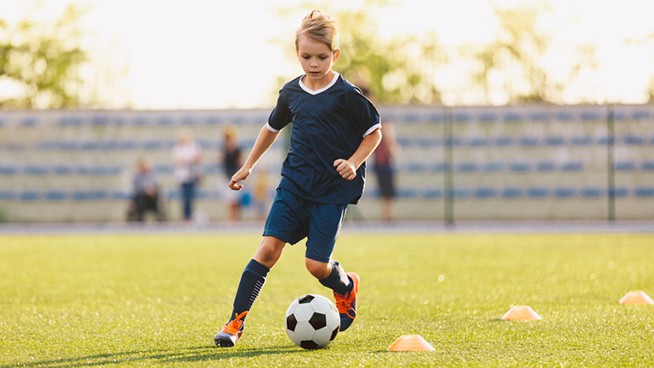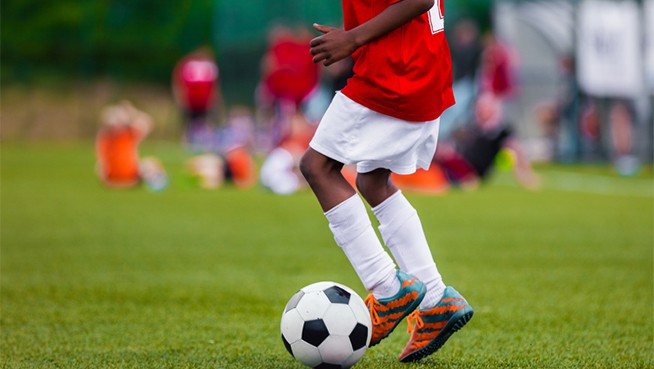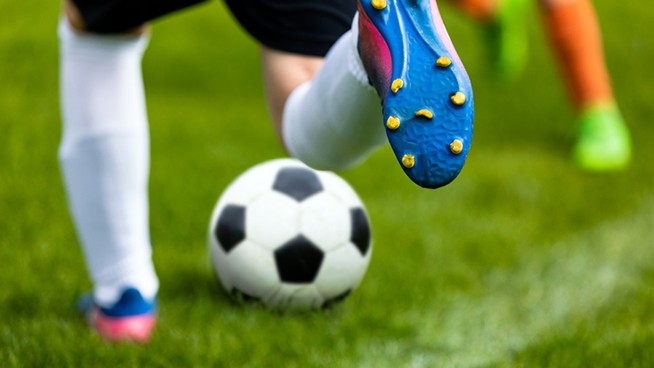4 Tips to Help Soccer Players Create Quicker Feet
This much I know: The feet are the foundation to a well-rounded soccer player.
Dazzling footwork is what gives the beautiful game pace and excitement, and it’s what separates technically proficient players from the rest.
Foot quickness is a key factor any time a player performs an explosive move past a defender, navigates their way out of tight pressure, executes a series of sharp cuts against a double team or performs a sharp turn to take a crack at goal.
Although it takes many components to build the total soccer athlete, such as strength, power and speed, we cannot ignore that soccer is a game built on foot quickness. If a player has slow, dragging feet, their game will suffer, especially from a technical standpoint.
Looking to soccer-specific skills, like cuts, fakes, step-overs and turns, the feet have to be dynamic for players to perform these efficiently and rapidly. Technical training should involve some degree of foot quickness without the ball, so players learn how to move and be nimble on their feet. Additionally, it should incorporate foot and ankle strengthening drills so players can further augment their quickness.
With that in mind, let’s take a look at five drills that can create quicker soccer players.
1. Low Box Lateral Shuffle
I am a huge fan of low box training for several reasons. For one, it moves athletes into ankle dorsiflexion, which is excellent for improved quickness and change of direction, as well as reduced chance of injury. The more we can get our athletes in an “athletic stance” with solid ankle dorsiflexion, the more we save the load on the anterior side of their bodies and keep them safeguarded from injury.
Perform 5 sets of 5-10 seconds, moving as fast as you can with good form. Utilize a 45-second recovery period between sets so players can perform each set with high intensity and quickness. To encourage players to move their feet quicker, I like to snap my fingers at a certain speed to elicit that response from them, or turn on fast music so their feet keep up with the beat.
2. Ladder Icky Shuffle, Icky Shuffle Race
Although most would say ladder drills are useless, I beg to differ. They certainly have a time and place for establishing and training things like the athletic stance, foot quickness and coordination.
The above “Icky Shuffle” pattern reinforces the foot quickness you’ll need to dribble in tight spaces. This can be a nice warm-up for a skills session or practice to get the feet awake and prepped for sharp moves. You can place a soccer ball at the end of the ladder to have the player transition into executing similar foot movements with the ball at their feet.
A progression of this drill involves having the players chase each other through the ladder, with the focus being to stay on their toes and move their feet as fast as possible:
3. Foot and Ankle Strengthening
The foot is made up of over 26 bones, 33 joints and 100-plus muscles, tendons and ligaments. With that said, it is paramount players don’t neglect the strength of their feet. Otherwise, how will their feet be able to withstand and perform soccer actions to their full potential? This is where foot and ankle strengthening exercises can provide a boost.
Some of my favorites are the Single-Leg Calf Raise (perform 2-3 sets of 10-15 reps on each side):
And Ankle Dorsiflexion with Band (performed 2-3 sets of 8-10 reps on each side):
This article features some other great foot and ankle-centric exercises.
4. Barefoot Training
Barefoot training (such as practicing your soccer skills, performing certain exercises and/or warming up for a workout without shoes) can be a great way to strengthen the many muscles, tendons and ligaments in your foot and ankle. A little goes a long way, so start with a couple times a week and go from there. It’s also important to exercise good judgement, as you don’t want to go barefoot in situations where your feet could get cut or injured.
Increased foot quickness will provide soccer players with an edge over their opponents, especially when it comes to executing technical skills. The feet, after all, are the foundation of the game, so train them relentlessly.
Photo Credit: franckreporter/iStock
READ MORE FROM ERICA SUTER:
RECOMMENDED FOR YOU
MOST POPULAR
4 Tips to Help Soccer Players Create Quicker Feet
This much I know: The feet are the foundation to a well-rounded soccer player.
Dazzling footwork is what gives the beautiful game pace and excitement, and it’s what separates technically proficient players from the rest.
Foot quickness is a key factor any time a player performs an explosive move past a defender, navigates their way out of tight pressure, executes a series of sharp cuts against a double team or performs a sharp turn to take a crack at goal.
Although it takes many components to build the total soccer athlete, such as strength, power and speed, we cannot ignore that soccer is a game built on foot quickness. If a player has slow, dragging feet, their game will suffer, especially from a technical standpoint.
Looking to soccer-specific skills, like cuts, fakes, step-overs and turns, the feet have to be dynamic for players to perform these efficiently and rapidly. Technical training should involve some degree of foot quickness without the ball, so players learn how to move and be nimble on their feet. Additionally, it should incorporate foot and ankle strengthening drills so players can further augment their quickness.
With that in mind, let’s take a look at five drills that can create quicker soccer players.
1. Low Box Lateral Shuffle
I am a huge fan of low box training for several reasons. For one, it moves athletes into ankle dorsiflexion, which is excellent for improved quickness and change of direction, as well as reduced chance of injury. The more we can get our athletes in an “athletic stance” with solid ankle dorsiflexion, the more we save the load on the anterior side of their bodies and keep them safeguarded from injury.
Perform 5 sets of 5-10 seconds, moving as fast as you can with good form. Utilize a 45-second recovery period between sets so players can perform each set with high intensity and quickness. To encourage players to move their feet quicker, I like to snap my fingers at a certain speed to elicit that response from them, or turn on fast music so their feet keep up with the beat.
2. Ladder Icky Shuffle, Icky Shuffle Race
Although most would say ladder drills are useless, I beg to differ. They certainly have a time and place for establishing and training things like the athletic stance, foot quickness and coordination.
The above “Icky Shuffle” pattern reinforces the foot quickness you’ll need to dribble in tight spaces. This can be a nice warm-up for a skills session or practice to get the feet awake and prepped for sharp moves. You can place a soccer ball at the end of the ladder to have the player transition into executing similar foot movements with the ball at their feet.
A progression of this drill involves having the players chase each other through the ladder, with the focus being to stay on their toes and move their feet as fast as possible:
3. Foot and Ankle Strengthening
The foot is made up of over 26 bones, 33 joints and 100-plus muscles, tendons and ligaments. With that said, it is paramount players don’t neglect the strength of their feet. Otherwise, how will their feet be able to withstand and perform soccer actions to their full potential? This is where foot and ankle strengthening exercises can provide a boost.
Some of my favorites are the Single-Leg Calf Raise (perform 2-3 sets of 10-15 reps on each side):
And Ankle Dorsiflexion with Band (performed 2-3 sets of 8-10 reps on each side):
This article features some other great foot and ankle-centric exercises.
4. Barefoot Training
Barefoot training (such as practicing your soccer skills, performing certain exercises and/or warming up for a workout without shoes) can be a great way to strengthen the many muscles, tendons and ligaments in your foot and ankle. A little goes a long way, so start with a couple times a week and go from there. It’s also important to exercise good judgement, as you don’t want to go barefoot in situations where your feet could get cut or injured.
Increased foot quickness will provide soccer players with an edge over their opponents, especially when it comes to executing technical skills. The feet, after all, are the foundation of the game, so train them relentlessly.
Photo Credit: franckreporter/iStock
READ MORE FROM ERICA SUTER:










